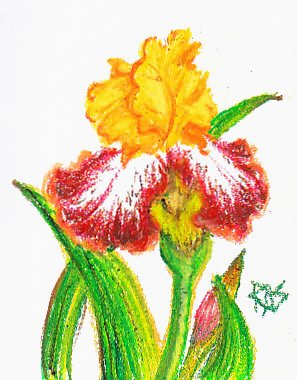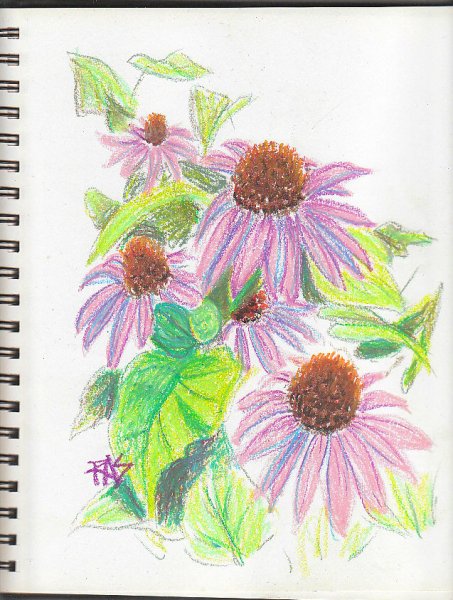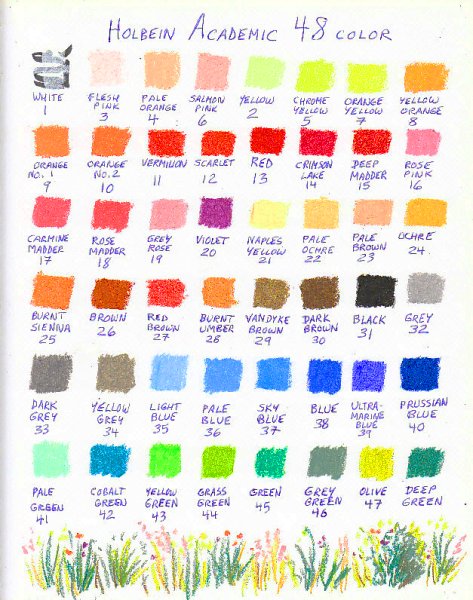|
Product Review -- Holbein Academic student grade oil pastels
Holbein Academic were the highest priced student grade set of oil pastels I purchased, at $39.50 for a set of 48 from Dick Blick. I was a bit put off by that, considering I had already invested in 100 artist grade Holbeins and didn't know if the Academic ones would be all that great. They're very good. Holbein Academic oil pastels are not much like their artist grade counterparts. The color range does not have a lot of tints, though it has some important ones. They are large round sticks about the size of Sennelier or Neopastel or Expressionist and have their own texture -- quite firm compared to the soft Holbein artist grade. My second surprise was the quality of the crumbles. Most oil pastels generate some crumbs while working. A few brands either generate very few or they're easier to blend back into their original color area. Other brands have serious problems with crumbling and spray crumbs that streak as soon as they touch any complement or light area or paper. The crumbs generated by Holbein Academic are not the large splashy ones that say, Loew-Cornell spawns with heavy pressure. They're very fine, almost powderlike and easily blend back in or blow away because they're so tiny. The barest touch with the stick presses them back into place. That's one of the unique qualities of this brand in this grade. They're firm and strong on pigment, but they're also fine-grained. I noticed that on toothy sketchbook paper, especially in doing the swatches for the color chart, that I could see light and dark variations on a miniscule scale within an otherwise smooth layer. As if they were translucent and the valleys of the paper filled with another layer of color. So they haven't really got the opacity of their artist grade cousins, but the colors are good and strong. Firmness and strong color gives Holbein Academic a lot of control. I could have done very hard edges if I'd wanted to try for photorealism, instead I did an expressive iris because the texture lent itself to broken lines and easy sketching. I found them very easy to sketch with when I started Bronze Iris. The initial lines went down lightly, broke around certain areas without any trouble and did not go out of control at the points I used heavy pressure. These are expressive oil pastels. I wound up doing a patch of loosely sketched grasses and flowers under the bottom of the color chart to fill the space instead of adding a mixing or shading bar, but I did complex mixtures within Bronze Iris that blended completely. The box is a heavy cardboard box with a cardboard insert rather than styrene trays. The sticks roll around a bit inside it and it came with a couple of rubberbands thoughtfully added by someone at Blick's warehouse, which did succeed in protecting them well in transit. Keep the rubberbands on the box if you put this in your backpack, you may want to run them in both directions instead of just around the short way. Printing on the box is minimal and no insert or booklet was included other than a thin plastic foam pad over the sticks. The wrappers show an AP nontoxic symbol, color name and number and Made in Japan. Holbein Academic went minimal on packaging, not a bad thing considering they may have spent the balance on a higher quantity of pigment in their student oil pastels. Lightfastness is not mentioned anywhere. Not on the sticks or the description at Blick or obviously, the box. I'm going to be very curious about the results of this year's independent testing. It may be that some colors in this range have artist grade lightfastness -- if so, those may be a good companion to the Holbein artist grade oil pastels as an underlayer combining hard and soft textures. These may well help softer layers adhere well to any surface with tooth. They're recommended for sketching -- and they are great for sketching. The texture invites sketching. I couldn't resist sketching with them even though I could have slowed down to do something tighter and more precise.

They're firm but a little bit sticky. Holbein Academic oil pastels adhere well to the paper, that's some of the way they react so well for sketching. When I put down a line it is going to stay where I put it and not slide when a stroke goes over it. I also found it easy on the swatches to fill in the white specks on the paper, they are sticky enough to go right down into the valleys so the swatches didn't take as long to bring them to full saturation. They are so different from Holbein artist grade that I'm happy I purchased the big set -- these are for different uses and their texture is so distinctive that I'm glad I've got both in my lineup. The color range is interesting. It's a classical painter's range, expanded a bit. Warm and cold primaries and a preponderance of certain important color groups. Ten or eleven earth tones -- eleven if you count Yellow Gray. Eight greens, six blues, only one violet, five reds, three pink, three orange, three yellow -- the palette is most suited to traditional landscapes and portraits. Three different skin highlights would bring the earth tones up to fourteen if I counted them in that range, it's a good palette for portraits and figures. Holbein Academic oil pastels were designed for traditional painting and drawing. I would find it easiest to do classical subjects with this range. They're cool, they now have their own special place in my oil pastels lineup and are not migrating away out of reach.

|





